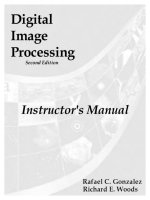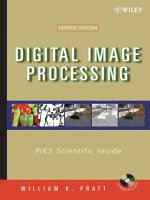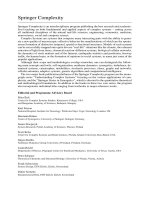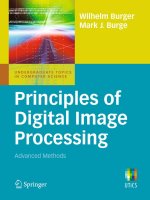cristobal, schelkens, thienpont - optical and digital image processing
Bạn đang xem bản rút gọn của tài liệu. Xem và tải ngay bản đầy đủ của tài liệu tại đây (11.41 MB, 939 trang )
Edited by
Gabriel Crist
´
obal, Peter Schelkens,
and Hugo Thienpont
Optical and Digital Image Processing
Related Titles
Ackermann, G. K., Eichler, J.
Holography
A Practical Approach
2007
ISBN: 978-3-527-40663-0
Ersoy, O. K.
Diffraction, Fourier Optics and
Imaging
2006
ISBN: 978-0-471-23816-4
Acharya, T., Ray, A. K.
Image Processing
Principles and Applications
2005
E-Book
ISBN: 978-0-471-74578-5
Singer, W., Totzeck, M., Gross, H.
Handbook of Optical Systems
Volume 2: Physical Image Formation
2005
ISBN: 978-3-527-40378-3
Edited by Gabriel Crist
´
obal, Peter Schelkens,
and Hugo Thienpont
Optical and Digital Image Processing
Fundamentals and Applications
The Editors
Dr. Gabriel Crist´obal
Instituto de Optica (CSIS)
Imaging and Vision Dept.
Serrano 121
28006 Madrid
Spain
Prof. Dr. Peter Schelkens
Vrije Universiteit Brussel
Department of Electronics and
Informatics (ETRO)
Pleinlaan 2
1050 Brussels
Belgium
Prof. Hugo Thienpont
Vrije Universiteit Brussel
Brussels Photonics Team (B-PHOT)
Pleinlaan 2
1050 Brussels
Belgium
All books published by Wiley-VCH are
carefully produced. Nevertheless, authors,
editors, and publisher do not warrant the
information contained in these books,
including this book, to be free of errors.
Readers are advised to keep in mind that
statements, data, illustrations, procedural
details or other items may inadvertently be
inaccurate.
Library of Congress Card No.: applied for
British Library Cataloguing-in-Publication
Data
A catalogue record for this book is available
from the British Library.
Bibliographic information published by the
Deutsche Nationalbibliothek
TheDeutscheNationalbibliothek
lists this publication in the Deutsche
Nationalbibliografie; detailed bibliographic
data are available on the Internet at
<>.
2011 WILEY-VCH Verlag GmbH & Co.
KGaA, Boschstraße. 12, 69469 Weinheim
All rights reserved (including those of
translation into other languages). No part
of this book may be reproduced in any
form – by photoprinting, microfilm, or any
other means – nor transmitted or translated
into a machine language without written
permission from the publishers. Registered
names, trademarks, etc. used in this book,
even when not specifically marked as such,
are not to be considered unprotected by law.
The copyright for the Matlab and other
software codes printed in this book remains
with the author.
Composition Laserwords Private Ltd.,
Chennai, India
Printing and Binding betz-druck GmbH,
Darmstadt
Cover Design Adam Design, Weinheim
Printed in Singapore
Printed on acid-free paper
ISBN: 978-3-527-40956-3
V
Foreword
Optical and Digital Image Processing
There is a tendency these days for scientists and engineers to be highly specialized.
It is therefore a pleasure to see a book covering a truly broad set of topics.
Granted that all the topics relate in one way or another to the field of optics,
broadly interpreted; however, within that broad category, this book certainly covers
a breadth of subjects.
The first element of breadth lies in the joint coverage of both optical signal
processing and digital signal processing. In fact, many modern signal processing
systems depend on both optics and digital technologies. Images are usually the
entity to be processed, and most often these images are formed by optical systems.
The methods for processing such images are numerous and diverse, depending in
large part upon the application.
At one time, optical analog processing held sway as the fastest method for
performing linear operations on 2D signals, but the relentless progress in digital
processing, a consequence of Moore’s law, has displaced optical processing in
many applications. However, the most interesting and complex optical systems
often entail some optical preprocessing followed by digital manipulation. Good
examples are found in the field of adaptive optics, in which optical methods for
wavefront sensing are followed by digital methods for determining appropriate
changes for an adaptive mirror.
The subject matter covered in this book ranges over many topics, which can
be broadly classified as follows: (i) fundamentals of both optics and digital signal
processing; (ii) optical imaging, including microscopy and holography; (iii) image
processing including compression, deconvolution, encryption, and pattern recog-
nition; (iv) signal representation, including time-frequency, spline, and wavelet
representations; and (v) miscellaneous applications, including medical imaging
and displays. The authors are drawn internationally, thus allowing a window into
the research interests of scientists and engineers in many countries.
As mentioned above, it is refreshing to see such breadth under one cover. This
book should provide interesting and informative reading to those wishing to see
VI Foreword
the broad picture of image processing and its applications through an international
lens.
Joseph W. Goodman
VII
Contents
Preface XXIX
List of Contributors XXXIX
Color Plates LI
1 Fundamentals of Optics 1
Ting-Chung Poon and Jung-Ping Liu
1.1 Introduction 1
1.2 The Electromagnetic Spectrum 1
1.3 Geometrical Optics 3
1.3.1 Ray Transfer Matrix 3
1.3.2 Two-Lens Imaging System 6
1.3.3 Aberrations 8
1.4 Maxwell’s Equations and the Wave Equation 9
1.5 Wave Optics and Diffraction 11
1.6 Fourier Optics and Applications 14
1.6.1 Ideal Thin Lens as Optical Fourier Transformer 14
1.6.2 Imaging and Optical Image Processing 17
1.6.3 Optical Correlator 19
1.7 The Human Visual System 21
1.8 Conclusion 23
References 23
2 Fundamentals of Photonics 25
Erik Stijns and Hugo Thienpont
2.1 Introduction 25
2.2 Interference and Diffraction 25
2.2.1 Interference 25
2.2.2 Diffraction 26
2.2.2.1 Diffraction at a One-Dimensional Slit 26
2.2.2.2 Diffraction at a Circular Aperture 27
2.2.3 Resolution 28
2.2.3.1 Angular Resolution 28
2.2.3.2 Spatial Resolution 29
VIII Contents
2.2.4 Coherence 29
2.2.4.1 Temporal or Longitudinal Coherence 29
2.2.4.2 Transverse or Spatial Coherence 30
2.3 Terms and Units: The Measurement of Light 30
2.3.1 Introduction: Radiometry versus Photometry 30
2.3.2 Radiometric Terms and Units 30
2.3.2.1 Radiant Energy 30
2.3.2.2 Radiant Flux 31
2.3.2.3 Radiant Flux Density 31
2.3.2.4 Radiant Intensity 31
2.3.2.5 Radiance 32
2.3.2.6 Radiant Exposure 32
2.3.3 Photometric Terms 33
2.3.3.1 Spectral Terms 33
2.3.3.2 Spectral Sensitivity of the Eye 33
2.3.3.3 Luminous Terms 33
2.3.4 Photometric Units 34
2.3.4.1 Other Visual Terms and Units 34
2.4 Color 35
2.4.1 Introduction 35
2.4.2 The Spectrum of Light 36
2.4.3 Tristimulus Theory 36
2.4.3.1 The Tristimulus 36
2.4.3.2 The 1931 CIE Standard 38
2.4.3.3 CIE 1976 UCS Diagram 39
2.4.4 Theory of the Opponent Colors 40
2.4.4.1 Describing the Visual Observations 40
2.4.4.2 Saturation or Chroma 41
2.4.4.3 Hue 41
2.4.4.4 The CIELAB Diagram 42
2.5 Basic Laser Physics 43
2.5.1 Introduction 43
2.5.2 Normal or Spontaneous Emission of Light 43
2.5.3 Absorption 44
2.5.4 Stimulated Emission of Light 44
2.5.5 Amplification 45
2.5.6 Basic Setup 45
2.6 Basic Properties of Laser Light 46
2.6.1 Laser Light Has One Direction 47
2.6.2 Laser Light Is Monochromatic 47
2.6.3 Laser Light Is Coherent 47
2.6.4 Laser Light Is Intense 47
2.7 Conclusions 48
References 48
Contents IX
3 Basics of Information Theory 49
Michal Dobes
3.1 Introduction 49
3.2 Probability 49
3.2.1 Several Events 50
3.2.2 Conditional Probabilities: Independent and Dependent
Events 51
3.2.3 Random Variable 52
3.2.4 Distribution Function 52
3.2.5 Discrete Distribution 53
3.2.6 Continuous Distribution 53
3.2.7 Expected Value 54
3.3 Entropy and Mutual Information 54
3.3.1 Historical Notes 55
3.3.2 Entropy 55
3.3.2.1 Some Properties of Entropy 55
3.3.3 Joint Entropy 56
3.3.4 Mutual Information 60
3.3.5 Kullback–Leibler Divergence 62
3.3.6 Other Types of Entropies 62
3.4 Information Channel 62
3.4.1 Discrete Channel 63
3.4.2 Channel Capacity 63
3.4.3 Symmetric Channel 64
3.4.4 Binary Symmetric Channel 65
3.4.5 Gaussian Channel 65
3.5 Conclusion 66
Appendix 3.A: Application of Mutual Information 67
References 68
4 Fundamentals of Image Processing 71
Vaclav Hlavac
4.1 Introduction 71
4.2 Digital Image Representation 73
4.2.1 Topological and Metric Properties of Images 74
4.2.2 Brightness Histogram 77
4.3 Image Filtering Paradigm 78
4.4 Frequency Domain 80
4.4.1 1D Fourier Transform 80
4.4.2 2D Fourier Transform 85
4.5 Filtering in the Image Domain 90
4.6 Conclusions 96
References 96
X Contents
5 Joint Spatial/Spatial-Frequency Representations 97
Gabriel Crist´obal, Salvador Gabarda, and Leon Cohen
5.1 Introduction 97
5.2 Fundamentals of Joint Representations 98
5.2.1 Notation 99
5.2.2 The Wigner Distribution 100
5.2.2.1 Marginals 101
5.2.2.2 Inversion 101
5.2.2.3 Translation Invariance 101
5.2.2.4 Product of Images 102
5.2.2.5 Overlap of Two Images 102
5.2.2.6 Real Images 102
5.2.2.7 Cross Wigner Distribution 103
5.3 Other Distributions 103
5.3.1 The Spectrogram 104
5.3.2 The Analytic Image 104
5.4 The Pseudo-Wigner–Ville Distribution (PWVD) 105
5.4.1 1D-Smoothed PWVD 105
5.4.2 1D Directional PWVD 105
5.4.3 2D-Smoothed PWVD Definition and Implementation 108
5.5 2D Log-Gabor Filtering Schemes for Image Processing 110
5.6 Texture Segmentation 112
5.7 Hybrid Optical–Digital Implementation 114
5.8 Conclusions 116
Acknowledgments 116
References 116
6 Splines in Biomedical Image Processing 119
Slavica Jonic and Carlos Oscar Sanchez Sorzano
6.1 Introduction 119
6.2 Main Theoretical Results about Splines 120
6.2.1 Splines as Interpolants and Basis Functions 120
6.2.1.1 Tensor Product Splines 120
6.2.1.2 Polyharmonic Splines 127
6.2.2 Splines for Multiscale Analysis 129
6.3 Splines in Biomedical Image and Volume Registration 131
6.4 Conclusions 132
References 133
7 Wavelets 135
Ann Dooms and Ingrid Daubechies
7.1 Introduction 135
7.2 Chasing Sherlock Holmes: How to Scrutinize an Image 139
7.2.1 Classical Fourier Analysis 140
7.2.2 Forces of Nature 141
Contents XI
7.3 A Natural Evolution: The Continuous Wavelet Transform 142
7.4 Theory into Practice: The Discrete Wavelet Transform 143
7.5 Mallat and Meyer Digging Deeper: Multiresolution Analysis 144
7.5.1 Examples 146
7.6 Going to Higher Dimensions: Directional Transforms 148
7.6.1 Separable Transforms 148
7.6.2 Dual-Tree Complex Wavelet Transform 149
7.6.3 Shearlets 151
7.7 Conclusion 152
References 153
8 Scale-Space Representations for Gray-Scale and Color Images 155
Iris U. Vanhamel, Ioannis Pratikakis, and Hichem Sahli
8.1 Introduction 155
8.2 Background 156
8.2.1 Definitions 156
8.2.2 Axioms and Properties 157
8.2.2.1 Fundamental Axioms 158
8.2.2.2 Properties 160
8.2.2.3 Morphological Properties 161
8.2.3 PDE Equation-Based Formulation 162
8.2.3.1 Classification 162
8.2.3.2 Well-Posedness 163
8.2.3.3 Solving the PDE 163
8.2.4 Variational Formulation 165
8.3 Representation 165
8.3.1 Gaussian Scale Space 165
8.3.2 Variable Conductance Diffusion 167
8.3.3 Geometry-Driven Scale Space 171
8.3.4 Mathematical Morphology Scale Space 173
8.4 Conclusions 176
References 176
9 Spatial Light Modulators (SLMs) 179
Philip M. Birch, Rupert Young, and Chris Chatwin
9.1 Introduction 179
9.2 Types of SLM 180
9.2.1 Liquid Crystal 180
9.2.1.1 Nematic Liquid Crystal SLMs 181
9.2.1.2 Frame Rates 183
9.2.1.3 Temperature Effects 184
9.2.1.4 Twisted Nematic LC-SLM 184
9.2.1.5 Modulation Methods 186
9.2.1.6 Ferroelectric 187
9.2.1.7 Addressing Methods 189
XII Contents
9.2.2 Multiple Quantum-Well SLMs 191
9.2.3 Mirror Devices 192
9.2.3.1 Amplitude Modulators 192
9.2.3.2 Phase Modulators 193
9.3 Fully Complex Modulation Methods 194
9.4 Applications 196
9.5 Conclusions 197
References 198
10 Holographic Visualization of 3D Data 201
Pierre-Alexandre Blanche
10.1 Introduction 201
10.2 Reproducing the Amplitude and the Phase 203
10.3 Different Types of Holograms 207
10.3.1 Transmission versus Reflection 207
10.3.2 Denisyuk Hologram 209
10.3.3 Color Reproduction 210
10.3.3.1 Reflection 211
10.3.3.2 Transmission 212
10.3.4 Phase versus Amplitude: The Diffraction Efficiency 213
10.3.5 Surface Relief Holograms 214
10.3.6 Thin versus Thick Hologram 215
10.4 Holographic Approximations 215
10.4.1 Rainbow Hologram 216
10.4.2 Holographic Stereogram 217
10.5 Dynamic Holography 220
10.5.1 Holographic Cinematography 220
10.5.2 Real-Time Integral Holography 222
10.5.3 Holographic Video 223
10.6 Conclusion 224
Acknowledgment 225
References 225
Further Reading 226
11 Holographic Data Storage Technology 227
Kevin Curtis, Lisa Dhar, and Pierre-Alexandre Blanche
11.1 Introduction 227
11.2 Holographic Data Storage Overview 228
11.2.1 Drive Architecture 231
11.2.2 Consumer Drive Implementation 233
11.3 Tolerances and Basic Servo 234
11.4 Data Channel Overview 236
11.5 Materials for Holography 237
11.5.1 Silver Halide Photographic Emulsion 238
11.5.2 Photopolymers 239
Contents XIII
11.5.3 Dichromated Gelatin 240
11.5.4 Miscellaneous Recording Media 241
11.5.4.1 Photothermoplastics 241
11.5.4.2 Photochromics 242
11.5.4.3 Photorefractive 242
11.6 Material for Data Storage 243
11.7 Media for Holographic Data Storage 246
11.8 Conclusions 246
References 247
12 Phase-Space Rotators and their Applications in Optics 251
Jos´e A. Rodrigo, Tatiana Alieva, and Martin J. Bastiaans
12.1 Introduction 251
12.2 Signal Representation in Phase Space: The Wigner Distribution 252
12.2.1 Description of Partially Coherent Light 252
12.2.2 Wigner Distribution 253
12.3 Matrix Formalism for the Description of Phase-Space Rotations 255
12.4 Basic Phase-Space Rotators for Two-Dimensional Signals 257
12.5 Optical System Design for Phase-Space Rotators and their
Experimental Implementations 260
12.6 Applications of Phase-Space Rotators in Optics 264
12.7 Conclusions 269
Acknowledgments 269
References 269
13 Microscopic Imaging 273
Gloria Bueno, Oscar D´eniz, Roberto Gonz´alez-Morales, Juan Vidal,
and Jes´us Salido
13.1 Introduction 273
13.2 Image Formation: Basic Concepts 274
13.2.1 Types of Image 274
13.2.2 Image Formation in the Optical Microscope 274
13.2.3 Light 275
13.2.4 Resolution 275
13.3 Components of a Microscopic Imaging System 276
13.4 Types of Microscopy 277
13.4.1 Bright-Field Microscopy 278
13.4.2 Phase Contrast Microscopy 279
13.4.3 Dark Contrast Microscopy 280
13.4.4 Differential Interference Contrast (DIC) Microscopy 281
13.4.5 Fluorescence Microscopy 282
13.4.6 Confocal Microscopy 283
13.4.7 Electron Microscopy 283
13.5 Digital Image Processing in Microscopy 284
13.5.1 Image Preprocessing 284
XIV Contents
13.5.2 Image Enhancement 286
13.5.3 Segmentation 287
13.5.4 Classification 289
13.6 Conclusions 292
Acknowledgments 292
References 292
14 Adaptive Optics in Microscopy 295
Martin J. Booth
14.1 Introduction 295
14.2 Aberrations in Microscopy 296
14.2.1 Definition of Aberrations 296
14.2.2 Representation of Aberrations 297
14.2.3 Effects of Aberrations in Microscopes 298
14.2.4 Sources of Aberrations in Microscopes 300
14.2.5 Effects of the Numerical Aperture 300
14.3 Principles of Adaptive Optics 301
14.3.1 Methods for Aberration Measurement 303
14.3.2 Aberration Correction Devices 305
14.4 Aberration Correction in High-Resolution Optical Microscopy 307
14.4.1 Microscope Configurations 307
14.4.2 Point-Scanning Microscopes 308
14.4.3 Widefield Microscopes 309
14.5 Aberration Measurement and Wavefront Sensing 312
14.5.1 Direct Wavefront Sensing in Microscopy 312
14.5.2 Indirect Wavefront Sensing 314
14.6 Control Strategies for Adaptive Microscopy 317
14.6.1 Choice of Signal for Wavefront Sensing 318
14.6.2 Aberration Dynamics 318
14.6.3 Field-Dependent Aberrations 319
14.7 Conclusion 320
Acknowledgments 321
References 321
15 Aperture Synthesis and Astronomical Image Formation 323
Anna Scaife
15.1 Introduction 323
15.2 Image Formation from Optical Telescopes 324
15.3 Single-Aperture Radio Telescopes 326
15.4 Aperture Synthesis 327
15.4.1 Principles of Earth Rotation Aperture Synthesis 327
15.4.2 Receiving System Response 330
15.5 Image Formation 333
15.5.1 Derivation of Intensity from Visibility 333
15.5.1.1 Full-Sky Imaging 335
Contents XV
15.5.2 Deconvolution Techniques 337
15.5.2.1 The CLEAN Algorithm 338
15.5.3 Maximum Entropy Deconvolution (The Bayesian Radio
Astronomer) 339
15.5.4 Compressed Sensing 342
15.6 Conclusions 343
References 343
16 Display and Projection 345
Tom Kimpe, Patrick Candry, and Peter Janssens
16.1 Introduction 345
16.2 Direct View Displays 345
16.2.1 Working Principle 345
16.2.2 Transmissive Displays 346
16.2.3 Emissive Displays 348
16.2.3.1 CRT Display 348
16.2.3.2 Plasma Display 349
16.2.3.3 LED Display 350
16.2.3.4 OLED Display 350
16.2.4 Reflective Displays 351
16.2.4.1 Reflective LCD 352
16.2.4.2 Electronic Paper (e-Paper) 352
16.3 Projection Displays 353
16.3.1 Basic Concepts and Key Components 353
16.3.2 Projector Architectures 356
16.3.2.1 Three-Panel Transmissive 357
16.3.2.2 Three-Panel Reflective 357
16.3.2.3 One-Panel Reflective DLP with UHP Lamp 358
16.3.2.4 One-Panel Reflective LCoS with High-Brightness LEDs 359
16.3.2.5 Three-Panel Grating Light Valve Projector 359
16.4 Applications 362
16.4.1 Medical Imaging Displays 362
16.4.1.1 Medical LCD Displays 362
16.4.1.2 Calibration and Quality Assurance of Medical Display Systems 362
16.4.2 Other Applications 364
16.5 Conclusion 366
References 366
17 3D Displays 369
Janusz Konrad
17.1 Introduction 369
17.2 Planar Stereoscopic Displays 370
17.2.1 Stereoscopic Displays with Glasses 371
17.2.1.1 Spectral Filtering 371
17.2.1.2 Light Polarization 373
XVI Contents
17.2.1.3 Light Shuttering 375
17.2.2 Autostereoscopic Displays (without glasses) 375
17.3 Planar Multiview Displays 378
17.3.1 Active Multiview 3D Displays 378
17.3.2 Passive Multiview 3D Displays 379
17.4 Signal Processing for 3D Displays 381
17.4.1 Enhancement of 3D Anaglyph Visualization 381
17.4.2 Ghosting Suppression in Polarized and Shuttered 3D Displays 382
17.4.3 Anti-Alias Filtering for Multiview Autostereoscopic Displays 384
17.4.4 Luminance/Color Balancing for Stereo Pairs 387
17.4.5 Intermediate View Interpolation 389
17.5 Conclusions 393
Acknowledgments 394
References 394
18 Linking Analog and Digital Image Processing 397
Leonid P. Yaroslavsky
18.1 Introduction 397
18.2 How Should One Build Discrete Representation of Images and
Transforms? 398
18.2.1 Signal Discretization 399
18.2.2 Imaging Transforms in the Mirror of Digital Computers 401
18.2.3 Characterization of Discrete Transforms in Terms of Equivalent
Analog Transforms 402
18.2.3.1 Point Spread Function and Frequency Response of a Continuous Filter
Equivalent to a Given Digital Filter 403
18.2.3.2 Point Spread Function of the Discrete Fourier Analysis 406
18.3 Building Continuous Image Models 408
18.3.1 Discrete Sinc Interpolation: The Gold Standard for Image
Resampling 408
18.3.1.1 Signal Recovery from Sparse or Nonuniformly Sampled Data 409
18.3.2 Image Numerical Differentiation and Integration 411
18.4 Digital-to-Analog Conversion in Digital Holography. Case Study:
Reconstruction of Kinoform 414
18.5 Conclusion 417
References 418
19 Visual Perception and Quality Assessment 419
Anush K. Moorthy, Zhou Wang, and Alan C. Bovik
19.1 Introduction 419
19.2 The Human Visual System 420
19.3 Human-Visual-System-Based Models 422
19.3.1 Visual Difference Predictor (VDP) 423
19.3.2 Visual Discrimination Model (VDM) 423
19.3.3 Teo and Heeger Model 423
Contents XVII
19.3.4 Visual Signal-to-Noise Ratio (VSNR) 424
19.3.5 Digital Video Quality Metric (DVQ) 424
19.3.6 Moving Picture Quality Metric (MPQM) 424
19.3.7 Scalable Wavelet-Based Distortion Metric for VQA 425
19.4 Feature-Based Models 425
19.4.1 A Distortion Measure Based on Human Visual
Sensitivity 425
19.4.2 Singular Value Decomposition and Quality 425
19.4.3 Curvature-Based Image Quality Assessment 426
19.4.4 Perceptual Video Quality Metric (PVQM) 426
19.4.5 Video Quality Metric (VQM) 426
19.4.6 Temporal Variations of Spatial-Distortion-Based VQA 427
19.4.7 Temporal Trajectory Aware Quality Measure 427
19.5 Structural and Information-Theoretic Models 427
19.5.1 Single-Scale Structural Similarity Index (SS-SSIM) 428
19.5.2 Multiscale Structural Similarity Index (MS-SSIM) 428
19.5.3 SSIM Variants 429
19.5.4 Visual Information Fidelity (VIF) 429
19.5.5 Structural Similarity for VQA 430
19.5.6 Video VIF 430
19.6 Motion-Modeling-Based Algorithms 430
19.6.1 Speed-Weighted Structural Similarity Index (SW-SSIM) 431
19.6.2 Motion-Based Video Integrity Evaluation (MOVIE) 431
19.7 Performance Evaluation and Validation 432
19.8 Conclusion 435
References 435
20 Digital Image and Video Compression 441
Joeri Barbarien, Adrian Munteanu, and Peter Schelkens
20.1 Introduction 441
20.2 Typical Architecture 441
20.3 Data Prediction and Transformation 442
20.3.1 Removing Data Redundancy 442
20.3.2 Spatial Prediction 443
20.3.3 Spatial Transforms 444
20.3.4 Color/Spectral and Multiple-Component Prediction and
Transforms 445
20.3.5 Temporal Redundancy Removal by Motion Estimation 445
20.3.5.1 Motion-Compensated Prediction 445
20.3.5.2 Improvements over the Basic Approach 447
20.4 Quantization 449
20.4.1 Principle 449
20.4.2 Lloyd–Max Quantizers 450
20.4.3 Embedded Quantization 451
20.5 Entropy Coding 452
XVIII Contents
20.5.1 Huffman Coding 452
20.5.2 Arithmetic Coding 453
20.6 Image and Volumetric Coding 455
20.6.1 Generic Image Coding 455
20.6.2 JPEG 456
20.6.3 JPEG 2000 456
20.7 Video Coding 457
20.7.1 H.261 458
20.7.2 H.264/AVC 459
20.8 Conclusions 460
Acknowledgments 460
References 460
21 Optical Compression Scheme to Simultaneously Multiplex and Encode
Images 463
Ayman Alfalou, Ali Mansour, Marwa Elbouz, and Christian Brosseau
21.1 Introduction 463
21.2 Optical Image Compression Methods: Background 464
21.3 Compression and Multiplexing: Information Fusion by Segmentation
in the Spectral Plane 466
21.4 Optical Compression of Color Images by Using JPEG and JPEG2000
Standards 470
21.4.1 Optical JPEG Implementation Results 472
21.4.2 Optical and Digital JPEG Comparison 473
21.4.3 Optical JPEG2000 Implementation 474
21.5 New Simultaneous Compression and Encryption Approach Based on a
Biometric Key and DCT 474
21.6 Conclusions 480
References 481
22 Compressive Optical Imaging: Architectures and Algorithms 485
Roummel F. Marcia, Rebecca M. Willett, and Zachary T. Harmany
22.1 Introduction 485
22.1.1 Organization of the Chapter 486
22.2 Compressive Sensing 486
22.3 Architectures for Compressive Image Acquisition 488
22.3.1 Coded Apertures 490
22.3.2 Compressive-Coded Apertures 492
22.4 Algorithms for Restoring Compressively Sensed Images 494
22.4.1 Current Algorithms for Solving the CS Minimization
Problem 494
22.4.2 Algorithms for Nonnegativity Constrained
2
–
1
CS
Minimization 496
22.4.3 Model-Based Sparsity 497
22.4.4 Compensating for Nonnegative Sensing Matrices 498
Contents XIX
22.5 Experimental Results 499
22.6 Noise and Quantization 502
22.7 Conclusions 502
Acknowledgments 503
References 503
23 Compressed Sensing: ‘‘When Sparsity Meets Sampling’’ 507
Laurent Jacques and Pierre Vandergheynst
23.1 Introduction 507
23.1.1 Conventions 508
23.2 In Praise of Sparsity 508
23.3 Sensing and Compressing in a Single Stage 510
23.3.1 Limits of the Shannon–Nyquist Sampling 510
23.3.2 New Sensing Model 511
23.4 Reconstructing from Compressed Information: A Bet on
Sparsity 512
23.5 Sensing Strategies Market 515
23.5.1 Random sub-Gaussian Matrices 516
23.5.2 Random Fourier Ensemble 516
23.5.3 Random Basis Ensemble 517
23.5.4 Random Convolution 517
23.5.5 Other Sensing Strategies 518
23.6 Reconstruction Relatives 518
23.6.1 Be Sparse in Gradient 518
23.6.2 Add or Change Priors 519
23.6.3 Outside Convexity 520
23.6.4 Be Greedy 520
23.7 Some Compressive Imaging Applications 521
23.7.1 Compressive Imagers 521
23.7.2 Compressive Radio Interferometry 523
23.8 Conclusion and the ‘‘Science 2.0’’ Effect 524
23.8.1 Information Sources 524
23.8.2 Reproducible Research 525
Acknowledgments 526
References 526
Further Reading 527
24 Blind Deconvolution Imaging 529
Filip
ˇ
Sroubek and Michal
ˇ
Sorel
24.1 Introduction 529
24.2 Image Deconvolution 530
24.3 Single-Channel Deconvolution 534
24.4 Multichannel Deconvolution 539
24.5 Space-Variant Extension 542
24.6 Conclusions 546
XX Contents
Acknowledgments 547
References 547
25 Optics and Deconvolution: Wavefront Sensing 549
Justo Arines and Salvador Bar´a
25.1 Introduction 549
25.2 Deconvolution from Wavefront Sensing (DWFS) 550
25.3 Past and Present 551
25.4 The Restoration Process 552
25.4.1 Estimating the Wave Aberration with Gradient-Based Wavefront
Sensors 553
25.4.2 PSF and OTF: Estimation Process and Bias 558
25.4.3 Significance of the Restoration Filter 559
25.4.4 Resolution of the Restored Image: Effective Cutoff Frequency 560
25.4.5 Implementation of the Deconvolution from Wavefront Sensing
Technique 562
25.5 Examples of Application 563
25.5.1 Astronomical Imaging 563
25.5.2 Eye Fundus Imaging 564
25.6 Conclusions 567
Acknowledgments 568
References 568
Further Reading 569
26 Image Restoration and Applications in Biomedical Processing 571
Filip Rooms, Bart Goossens, Aleksandra Piˇzurica, and Wilfried Philips
26.1 Introduction 571
26.2 Classical Restoration Techniques 574
26.2.1 Inverse Filter and Wiener Filter 574
26.2.1.1 Inverse Filter 574
26.2.1.2 Wiener Filter 575
26.2.2 Bayesian Restoration 577
26.2.2.1 Gaussian Noise Model 578
26.2.3 Poisson Noise Model 580
26.2.3.1 Richardson–Lucy Restoration 580
26.2.3.2 Classical Regularization of Richardson–Lucy 581
26.3 SPERRIL: Estimation and Restoration of Confocal Images 583
26.3.1 Origin and Related Methods 583
26.3.2 Outline of the Algorithm 584
26.3.2.1 Noise Reduction 584
26.3.2.2 Deblurring Step 585
26.3.2.3 SPERRIL as RL with a Prior? 585
26.3.3 Experimental Results 586
26.3.3.1 Colocalization Analysis: What and Why? 586
26.3.3.2 Experimental Setup 586
Contents XXI
26.4 Conclusions 589
Acknowledgment 589
References 590
27 Optical and Geometrical Super-Resolution 593
Javier Garcia Monreal
27.1 Introduction 593
27.2 Fundamental Limits to Resolution Improvement 594
27.3 Diffractive Optical Super-Resolution 595
27.3.1 Optical System Limitations and Super-Resolution Strategy 595
27.3.2 Nonholographic Approaches 597
27.3.2.1 Time Multiplexing 597
27.3.2.2 Angular Multiplexing 600
27.3.2.3 Multiplexing in Other Degrees of Freedom 601
27.3.3 Holographic Approaches 602
27.3.3.1 Holographic Wavefront Coding 602
27.3.3.2 Multiplexed Holograms 603
27.3.3.3 Digital Holography 604
27.3.3.4 Axial Super-Resolution 607
27.4 Geometrical Super-Resolution 608
References 611
28 Super-Resolution Image Reconstruction considering Inaccurate
Subpixel Motion Information 613
Jongseong Choi and Moon Gi Kang
28.1 Introduction 613
28.2 Fundamentals of Super-Resolution Image Reconstruction 614
28.2.1 Basic Concept of Super-Resolution 614
28.2.2 Observation Model 616
28.2.3 Super-Resolution as an Inverse Problem 617
28.2.3.1 Constrained Least Squares Approach 617
28.2.3.2 Bayesian Approach 618
28.2.4 The Frequency Domain Interpretation 621
28.3 Super-Resolution Image Reconstruction considering Inaccurate
Subpixel Motion Estimation 623
28.3.1 Analysis of the Misregistration Error 623
28.3.2 Multichannel-Regularized Super-Resolution Image Reconstruction
Algorithm 624
28.3.3 Experimental Results 628
28.4 Development and Applications of Super-Resolution Image
Reconstruction 631
28.4.1 Super-Resolution for Color Imaging Systems 632
28.4.2 Simultaneous Enhancement of Spatial Resolution and Dynamic
Range 634
28.4.3 Super-Resolution for Video Systems 636
XXII Contents
28.5 Conclusions 640
Acknowledgments 640
References 641
29 Image Analysis: Intermediate-Level Vision 643
Jan Cornelis, Aneta Markova, and Rudi Deklerck
29.1 Introduction 643
29.2 Pixel- and Region-Based Segmentation 645
29.2.1 Supervised Approaches 646
29.2.1.1 Classification Based on MAP (Maximizing the A posteriori
Probability) 646
29.2.2 Unsupervised Approaches 647
29.2.2.1 K-means Clustering 648
29.2.2.2 Expectation-Maximization (EM) 649
29.2.3 Improving the Connectivity of the Classification Results 650
29.2.3.1 Seeded Region Growing 651
29.2.3.2 Mathematical Morphology 651
29.3 Edge-Based Segmentation 652
29.3.1 Optimal Edge Detection and Scale-Space Approach 654
29.4 Deformable Models 654
29.4.1 Mathematical Formulation (Continuous Case) 655
29.4.2 Applications of Active Contours 657
29.4.3 The Behavior of Snakes 658
29.5 Model-Based Segmentation 661
29.5.1 Statistical Labeling 662
29.5.2 Bayesian Decision Theory 662
29.5.3 Graphs and Markov Random Fields Defined on a Graph 662
29.5.4 Cliques 663
29.5.5 Models for the Priors 663
29.5.6 Labeling in a Bayesian Framework based on Markov Random Field
Modeling 663
29.6 Conclusions 664
References 664
30 Hybrid Digital–Optical Correlator for ATR 667
Tien-Hsin Chao and Thomas Lu
30.1 Introduction 667
30.1.1 Gray-Scale Optical Correlator System’s Space–Bandwidth Product
Matching 669
30.1.2 Input SLM Selection 671
30.2 Miniaturized Gray-Scale Optical Correlator 673
30.2.1 512 × 512 GOC System Architecture 673
30.2.2 Graphic User Interface of the GOC System 674
30.2.3 Gray-Scale Optical Correlator Testing 675
30.2.4 Summary 676
Contents XXIII
30.3 Optimization of OT-MACH Filter 677
30.3.1 Optimization Approach 677
30.4 Second Stage: Neural Network for Target Verification 681
30.4.1 Feature Extraction Methods 682
30.4.1.1 Horizontal and Vertical Binning 682
30.4.1.2 Principal Component Analysis 684
30.4.2 Neural Network Identification 686
30.4.2.1 Neural Network Algorithm 686
30.5 Experimental Demonstration of ATR Process 687
30.5.1 Vehicle Identification 687
30.5.2 Sonar Mine Identification 689
30.6 Conclusions 690
Acknowledgments 692
References 692
31 Theory and Application of Multispectral Fluorescence Tomography 695
Rosy Favicchio, Giannis Zacharakis, Anikitos Garofalakis,
and Jorge Ripoll
31.1 Introduction 695
31.2 Fluorescence Molecular Tomography (FMT) 696
31.2.1 FMT Principle 696
31.2.2 Theoretical Background 697
31.2.2.1 Optical Parameters 698
31.2.2.2 The Diffusion Equation 699
31.2.2.3 Solutions of the Diffusion Equation for Infinite Homogeneous
Media 699
31.2.2.4 The Excitation Source Term 700
31.2.2.5 The Fluorescence Source Term 700
31.2.2.6 The Born Approximation for the Excitation Term 702
31.2.2.7 Boundary Conditions 702
31.2.2.8 Inverse Problem 703
31.2.2.9 The Normalized Born Approximation 703
31.2.3 Experimental Setup 705
31.3 Spectral Tomography 706
31.3.1 Spectral Deconvolution 707
31.4 Multitarget Detection and Separation 709
31.4.1 Multicolor Phantom 709
31.4.1.1 In vitro Fluorophore Unmixing 709
31.4.1.2 Methodology 709
31.4.2 In vivo Study 711
31.4.2.1 In vivo Fluorophore Unmixing 711
31.4.2.2 Methodology 711
31.5 Conclusions 712
References 713
XXIV Contents
32 Biomedical Imaging Based on Vibrational Spectroscopy 717
Christoph Krafft, Benjamin Dietzek, and J¨urgen Popp
32.1 Introduction 717
32.2 Vibrational Spectroscopy and Imaging 718
32.2.1 Infrared Spectroscopy 718
32.2.2 Raman Spectroscopy 720
32.2.3 Coherent Anti-Stokes–Raman Scattering Microscopy 721
32.3 Analysis of Vibrational Spectroscopic Images 723
32.3.1 Preprocessing 723
32.3.1.1 Quality Test 723
32.3.1.2 Denoising 724
32.3.1.3 Background and Baseline Correction 724
32.3.1.4 Normalization 724
32.3.1.5 Image Compression 725
32.3.2 Exploratory Image Analysis 725
32.3.2.1 Classical Image Representations 725
32.3.2.2 Principal Component Analysis 726
32.3.3 Image Segmentation: Cluster Analysis 728
32.3.4 Supervised Image Segmentation: Linear Discriminant Analysis 729
32.4 Challenges for Image Analysis in CARS Microscopy 730
32.4.1 Particle Identification in Nonlinear Microscopy 731
32.4.2 Numerical Reduction or Suppression of Nonresonant
Background 732
32.4.3 Outlook – Merging CARS Imaging with Chemometrics 734
32.5 Biomedical Applications of Vibrational Spectroscopic Imaging: Tissue
Diagnostics 734
32.6 Conclusions 736
Acknowledgments 736
References 736
33 Optical Data Encryption 739
Maria Sagrario Mill´an Garc´ıa-Varela and Elisabet P´erez-Cabr´e
33.1 Introduction 739
33.2 Optical Techniques in Encryption Algorithms 740
33.2.1 Random Phase Mask (RPM) and Phase Encoding 740
33.2.2 Double-Random Phase Encryption (DRPE) 741
33.2.3 Resistance of DRPE against Attacks 746
33.2.4 Encryption Algorithms Based on Real (Phase-Only and
Amplitude-Only) Functions 748
33.2.5 Holographic Memory 749
33.2.6 Wavelength Multiplexing and Color Image Encryption 750
33.2.7 Fresnel Domain 751
33.2.8 Fractional Fourier Transforms 753
33.3 Applications to Security Systems 755
33.3.1 Optical Techniques and DRPE in Digital Cryptography 755
Contents XXV
33.3.2 Multifactor Identification and Verification of Biometrics 756
33.3.3 ID Tags for Remote Verification 759
33.4 Conclusions 765
Acknowledgments 765
References 765
34 Quantum Encryption 769
Bing Qi, Li Qian, and Hoi-Kwong Lo
34.1 Introduction 769
34.2 The Principle of Quantum Cryptography 770
34.2.1 Quantum No-Cloning Theorem 770
34.2.2 The BB84 Quantum Key Distribution Protocol 771
34.2.3 Entanglement-Based Quantum Key Distribution Protocol 774
34.2.4 Continuous Variable Quantum Key Distribution Protocol 776
34.3 State-of-the-Art Quantum Key Distribution Technologies 777
34.3.1 Sources for Quantum Key Distribution 777
34.3.1.1 Single-Photon Source 777
34.3.1.2 EPR Photon Pair 778
34.3.1.3 Attenuated Laser Source 778
34.3.2 Quantum State Detection 779
34.3.2.1 Single-Photon Detector 779
34.3.2.2 Optical Homodyne Detector 780
34.3.3 Quantum Random Number Generator 781
34.3.4 Quantum Key Distribution Demonstrations 781
34.3.4.1 QKD Experiments through Telecom Fiber 781
34.3.4.2 QKD Experiments through Free Space 782
34.4 Security of Practical Quantum Key Distribution Systems 783
34.4.1 Quantum Hacking and Countermeasures 783
34.4.2 Self-Testing Quantum Key Distribution 784
34.5 Conclusions 785
Acknowledgments 786
References 786
35 Phase-Space Tomography of Optical Beams 789
Tatiana Alieva, Alejandro C´amara, Jos´eA.Rodrigo,andMar´ıa L. Calvo
35.1 Introduction 789
35.2 Fundamentals of Phase-Space Tomography 790
35.3 Phase-Space Tomography of Beams Separable in Cartesian
Coordinates 793
35.4 Radon Transform 794
35.5 Example: Tomographic Reconstruction of the WD of Gaussian
Beams 796
35.6 Experimental Setup for the Measurements of the WD Projections 798
35.7 Reconstruction of WD: Numerical and Experimental Results 800
35.8 Practical Work for Postgraduate Students 802









